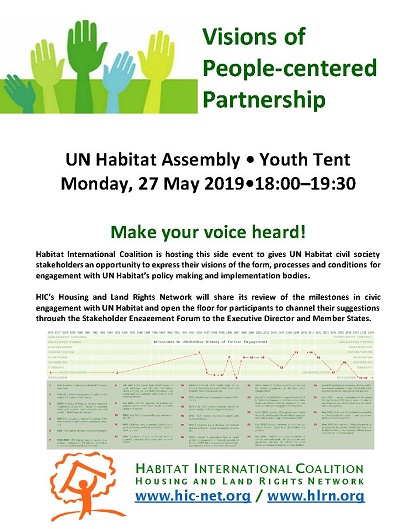“Visions of People-centered Partnership”
HIC-HLRN event at the first UN Habitat Assembly, Nairobi, 28 May 2019
On 27 May 2019, Habitat International Coalition – Housing and Land Rights Network organized a side event at the first UN Habitat Assembly (Nairobi) in collaboration with UN Habitat’s stakeholder Youth Caucus. The inter-active event sought to collect participants’ “Visions of People-centered Partnership” with UN Habitat in the implementation of the “New Urban Agenda” (NUA) toward the Sustainable Development Goals.
In the Youth Tent, HIC-HLRN presented the outcome of its review of stakeholder partnership with UN Habitat in a graphic. It charts the ups and downs of that relationship, particularly with civil society and local government stakeholders, in the UN Habitat policy spaces since 1976. HIC-HLRN has projected that pattern upon a “ladder of participation,” applying social science criteria to measure the degrees and quality of civic engagement in policy decision making and implementation.
HIC Board Member Ify Ofong (Women in Development and Environment, Nigeria) opened the session, and HIC former president and Wisdom Keeper (Davinder Lamba (Mazingira Institute, Kenya) welcomed the participants. Davinder shared the HICstory of advocating strong and effective partnership of diverse civil society organizations and municipalities since UN Habitat’s inception 43 years ago.
Joseph Schechla, coordinator of HIC-HLRN in the MENA region, presented the methodology and chart of UN Habitat stakeholder-engagement milestones, then opened the floor for the participants to express their visions of people-centered participation to be channeled to the Concept Committee that has emerged from the previous weekend’s Global Stakeholders Forum, and through the Stakeholder Advisory Group newly appointed by the UN Habitat Executive Director.
The comments and questions from the participants were critical of existing stakeholder-engagement structures and aligned with the UN General Assembly’s call for UN Habitat to rationalize its stakeholder-engagement structures. The participants reflected the UN Habitat suggestion for a self-organized engagement mechanism and coincided with HIC’s proposal for a self-organized civil society mechanism for UN Habitat. More specifically, the participant observations and recommendations called for:
-
A thorough review and re-assessment of civil society’s role in cooperation with UN Habitat, considering the interactivity within UN Habitat policy spaces against evaluation criteria to focus on creating and developing alternative civic-engagement structures and processes.
-
Re-thinking civil strategy to ensure the regular engagement of grassroots groups and communities affected by housing and habitat development projects, including the small-scale farmers and indigenous peoples Habitat Agenda Partners that have been alienated by the narrowing of the foregoing Habitat Agenda into a “New Urban Agenda.”
-
Taking advantage of the historic lessons learnt and experiences from the “wisdom keepers” and human rights defenders in civil society and their struggles over the past decades.
-
Advocating alternatives to the trend of commercialization/commodification of basic human needs and services in the local and national spheres that have become a detriment to people’s right to an adequate standard of living and livelihood even greater than classic corruption.
-
Expanding opportunities to collaborate and engage with local government and municipalities, which—like civil society—have been intermittently excluded from the global policy-making processes, notably in UN Habitat.
-
Recalling the UN Charter in order to hold UN Habitat and its officed to their duty to integrate and simultaneously operationalize the Charter’s three purposeful pillars: human rights, sustainable development and peace and security.
-
Orienting the new self-organized stakeholder mechanism(s) accordingly to build capacity and to distribute and complement efforts, building on lessons learnt over the past decades, while continuing and reinforcing engagement with UN Habitat in the future.
-
Ensuring that any new stakeholder-engagement mechanism(s) enable free and critical thinking to be expressed to UN Habitat without forcing consensus, homogenizing and, thus, “dumbing down” messages to their lowest common denominator by mixing self-interested stakeholders with publicly interested and plural-interest bearing civil society.
-
Applying the repeatedly learnt lesson that top-down appointed stakeholder bodies of self-representing individuals invariably fail to achieve legitimacy, credibility or relevance among constituents.
-
Reviewing and comparatively analyzing current stakeholder mechanisms across the UN System to arrive at one, or a hybrid model that best suits the diverse civil society among the multiple stakeholders and purposes of UN Habitat and the NUA. This recommendation coincides with the expectation that the Stakeholder Engagement Forum’s Concept Committee producing a proposal for the engagement mechanism(s) to be presented at World Urban Forum 10 (2020).
See also:
HIC-HLRN “Charting UN Habitat-Stakeholder Engagement” (chart)
HIC Open Letter to UN Habitat Executive Director Maimunah Mohammad Sharif
Extended version of “Milestones of UN Habitat Cooperation with Stakeholders: Forward and Backward” (chronology)
HIC proposed civil society mechanism for UN Habitat
Download














